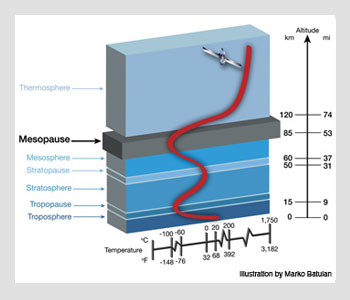Feature
Laser-Induced Fluorescence: Spectroscopy in the Sky
Scientists are using laser-induced fluorescence to assess temperature and wind in a largely unstudied layer of the Earth’s atmosphere. Their results are crucial to our understanding of solar-terrestrial relations and lay the groundwork for studies of global warming and atmospheric turbulence.

Mesopause: The coldest place on Earth
Annual mean temperatures across each layer of the Earth’s atmosphere. Interestingly, summer is colder than winter in the mesopause. It reaches as low as -150° C in the polar region, when tiny ice particles form noctilucent clouds. At pressures of 2 x 10-6 atm., the air is dense enough to ablate meteoroids.
It has long been a challenge for scientists to make in situ measurements of the mesopause region of the Earth’s atmosphere (80 to 110 km in altitude), because it is too high for airplanes and balloons, but too low for satellites. Meteorological rockets reach altitudes up to about 90 km. Although sounding rockets can reach well beyond that, they are rather infrequent. Exploring the thermal structure of the mesopause by remote sensing from space has also proven to be difficult—and in some ways even problematic—owing to its limited local time coverage. This scarcity of observations had earned for the region the nickname “the Ignorosphere.”
…Log in or become a member to view the full text of this article.
This article may be available for purchase via the search at Optica Publishing Group.
Optica Members get the full text of Optics & Photonics News, plus a variety of other member benefits.
